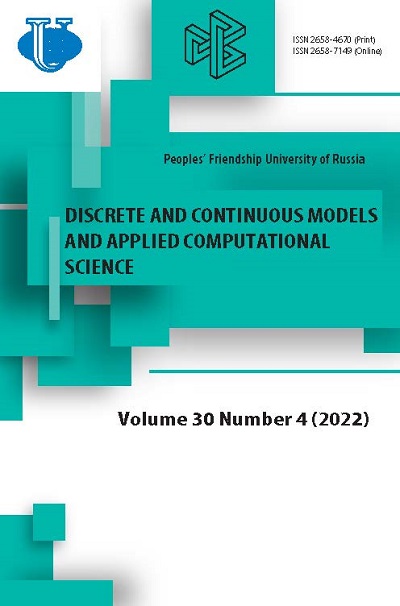Profile thickness synthesis of thin-film waveguide Luneburg lens
- Authors: Lovetskiy K.P.1, Sevastianov A.L.2, Zorin A.V.1
-
Affiliations:
- Peoples’ Friendship University of Russia (RUDN University)
- Higher School of Economics (HSE University)
- Issue: Vol 30, No 4 (2022)
- Pages: 357-363
- Section: Articles
- URL: https://journals.rudn.ru/miph/article/view/33016
- DOI: https://doi.org/10.22363/2658-4670-2022-30-4-357-363
- ID: 33016
Cite item
Full Text
Abstract
In the work the link between the focusing inhomogeneity of the effective refractive index of waveguide Luneburg lens and the irregularity of the waveguide layer thickness generating this inhomogeneity is demonstrated. For the dispersion relation of irregular thin-film waveguide in the model of adiabatic waveguide modes the problem of mathematical synthesis and computer-aided design of the waveguide layer thickness profile for the Luneburg thin-film generalized waveguide lens with a given focal length is being solved. The calculations are carried out in normalized (in a special way) coordinates to adapt the used relations to computer calculations. The obtained solution is compared with the same solution within the cross-section’s method. The performance of the algorithm implemented in Delphi, was demonstrated by plotting the dispersion curves and plotting a family of dispersion curves, demonstrating a critical convergence. As an additional result, the thickness profiles of additional (irregular in thickness) waveguide layer, forming a thin film generalized waveguide Luneburg lens were synthesized. This result generalizes Southwell’s results.
Full Text
1. Model of adiabatic waveguide modes Using the example of a thin film generalized waveguide Luneburg (TGWL) lens (see figure 1), which performs a two-dimensional Fourier transform with a finite aperture, the application of the adiabatic mode model is demonstrated. The inverse problem of synthesizing a thin film generalized waveguide Luneburg (TGWL) lens is solved within the framework of the model of adiabatic waveguide modes. Figure 1. Cross section of the TGWL under consideration Solutions of the Maxwell’s equations for adiabatic waveguide modes are sought in the form [1]: {E(About the authors
Konstantin P. Lovetskiy
Peoples’ Friendship University of Russia (RUDN University)
Author for correspondence.
Email: lovetskiy-kp@rudn.ru
ORCID iD: 0000-0002-3645-1060
Candidate of Physical and Mathematical Sciences, Associate Professor of Department of Applied Probability and Informatics
6, Miklukho-Maklaya St., Moscow, 117198, Russian FederationAnton L. Sevastianov
Higher School of Economics (HSE University)
Email: alsevastyanov@gmail.com
ORCID iD: 0000-0002-0280-485X
Candidate of Physical and Mathematical Sciences, Deputy Head of Department of Education digitalization
11, Pokrovsky Bulvar, Moscow, 109028, Russian FederationAlexander V. Zorin
Peoples’ Friendship University of Russia (RUDN University)
Email: zorin-av@rudn.ru
ORCID iD: 0000-0002-5721-4558
Doctor of Physical and Mathematical Sciences, Assistant Professor of Department of Applied Probability and Informatics
6, Miklukho-Maklaya St., Moscow, 117198, Russian FederationReferences
- A. L. Sevastyanov, “Computer modeling of directed modes’ fields of thin-film generalized waveguide Luneburg lens. Candidate’s Dissertation in Physics and Mathematics [Komp’yuternoe modelirovanie polej napravlyaemyh mod tonkoplenochnoj obobshchennoj volnovodnoj linzy Lyuneberga],” in Russian, Ph.D. dissertation, Peoples’ Friendship University of Russia, Moscow, 2010.
- L. A. Sevast’yanov and A. A. Egorov, “Theoretical analysis of the waveguide propagation of electromagnetic waves in dielectric smoothlyirregular integrated structures,” Optics and Spectroscopy, no. 105, pp. 576-584, 2008. doi: 10.1134/S0030400X08100123.
- A. A. Egorov and L. A. Sevast’yanov, “Structure of modes of a smoothly irregular integrated-optical four-layer three-dimensional waveguide,” Quantum Electronics, vol. 39, no. 6, pp. 566-574, 2009. doi: 10.1070/QE2009v039n06ABEH013966.
- A. A. Egorov, K. P. Lovetskii, A. L. Sevast’yanov, and L. A. Sevast’yanov, “Simulation of guided modes (eigenmodes) and synthesis of a thin-film generalised waveguide Luneburg lens in the zero-order vector approximation,” Quantum Electronics, vol. 40, no. 9, pp. 830-836, 2010. doi: 10.1070/QE2010v040n09ABEH014332.
- L. A. Sevastianov, A. A. Egorov, and A. L. Sevastyanov, “Method of adiabatic modes in studying problems of smoothly irregular open waveguide structures,” Physics of Atomic Nuclei, vol. 76, pp. 224-239, 2013. doi: 10.1134/S1063778813010134.
- W. H. Southwell, “Inhomogeneous optical waveguide lens analysis,” Journal of the Optical Society of America, vol. 67, no. 8, pp. 1004-1009, 1977. doi: 10.1364/JOSA.67.001004.
- W. H. Southwell, “Index profiles for generalized Luneburg lenses and their use in planar optical waveguides,” Journal of the Optical Society of America, vol. 67, no. 8, pp. 1010-1014, 1977. doi: 10.1364/JOSA.67.001010.
- E. Fehlberg, “Low-order Classical Runge-Kutta formulas with step size control,” NASA Technical Report R-315, Tech. Rep., 1969.
- A. L. Sevastyanov, “Structure of modes of smoothly irregular threedimensional integrated optical four-layer waveguide,” Physics of Particles and Nuclei Letters, vol. 8, no. 479, pp. 804-811, 2011. doi: 10.1134/S1547477111050177.
- A. A. Egorov et al., “Stable computer modeling of thin-film generalized waveguide Luneburg lens [Ustojchivoe komp’yuternoe modelirovanie tonkoplenochnoj obobshchennoj volnovodnoj linzy Lyuneberga],” Matem. modelirovaniye, vol. 26, no. 11, pp. 37-44, 2014, in Russian.
Supplementary files















